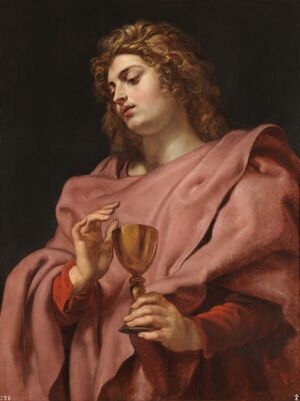John the Beloved
John the Beloved was the closest disciple of Jesus the Christ. He authored the Book of Revelation, which was dictated by Jesus, “sent and signified by his angel.” He who best understood the mystical teachings of the Christ ascended at the close of that embodiment, the only one of the twelve apostles to do so.

His lifetimes on earth
Under the guardianship of Joseph, the protector of Mary and Jesus, John and his brother James received training in the Essene community. Having beheld Jesus enter the inner temple while he was worshiping without, John sensed the destiny of the Christ. Years later when the call came, he was ready to follow his Lord and Master.
John’s magnetization of the love ray was the greatest of any of the disciples. This love he expressed not only for Jesus, but also for the light of the Christ within him and for his mission, which he, above all, understood and shared. John has told us that his love for Jesus was so great that in order to make his ascension he had to learn the meaning of impersonal love.
John was the only disciple who did not forsake Jesus as he was dying on the cross. As Jesus saw John standing nearby with Mary, he said to her, “Woman, behold thy son!” and said to John, “Behold thy Mother!”[1] Jesus thereby acknowledged John as his spiritual brother, as worthy to be the son of his own mother—and therefore, he elevated John to the level of Christ.
John embodied the full person of the Christ Self, and unless this had been true, Jesus would not have created that relationship, because Mary was Mother in the archetypal sense of Universal Mother—she embodied the Mother flame. When Jesus called John her son, he was speaking not just in the physical sense but also in the universal sense of the Son of God, the Son of the Divine Mother, whose representative she was.
John stayed in Jerusalem for some time during the persecutions following Jesus’ resurrection. After the martyrdom of Peter and Paul, John settled in Ephesus, the greatest city of Asia Minor, where Paul had centered his missionary activities. There is a tradition, which is confirmed by Tertullian and Jerome, that during the reign of Domitian, John was taken to Rome where an attempt to put him to death in a cauldron of boiling oil was miraculously thwarted. (This is the test of fire that was also faced by Shadrach, Meshach and Abednego.[2]) He emerged from the cauldron unharmed and was then banished to the island of Patmos. Here he received and recorded the Book of Revelation.
After the death of Domitian in the year A.D. 96, John could return to Ephesus, and many believe that he wrote his Gospel and three epistles at that time, when he was in his nineties. John is said to have passed his last years at Ephesus, and to have died there at a great age, outliving all the other apostles. According to some, he simply “disappeared”—was translated like Elijah or “assumed” into heaven as was the Blessed Virgin. Others testify to the miracles wrought from the dust of his tomb.
In an earlier embodiment, John was Benjamin, the youngest brother of Joseph, the idle dreamer, who later embodied as Jesus. Of his eleven brothers (all of whom served as his disciples in his final embodiment), Joseph loved Benjamin the most.
His service today
John uses as his symbol a purple Maltese Cross superimposed upon a pink Maltese Cross with gold radiance surrounding it. The flame focused in his retreat in the etheric realms above the state of Arizona is purple and gold. Through this flame, which focuses the power of divine love in its four phases, he teaches the mastery of fire, air, water and earth as the four aspects of the nature of God.
This hope is also held by beloved John and the brothers and sisters who serve in his retreat, who teach the impersonal impersonality of divine love through the mastery of the fire element, the impersonal personality of divine love through the mastery of the air element, the personal personality of divine love through the mastery of the water element, and the personal impersonality of divine love through the mastery of the earth element. (These four aspects of God’s consciousness correspond to God as Father, Son, Mother and Holy Spirit.)
Students who desire to study these four aspects of the nature of God and how they can solve the problems of our civilization that are the result of the perversions of the love ray on the planet may ask to be taken to John the Beloved’s retreat while they sleep.
See also
Sources
Mark L. Prophet and Elizabeth Clare Prophet, The Masters and Their Retreats, s.v. “John the Beloved.”
